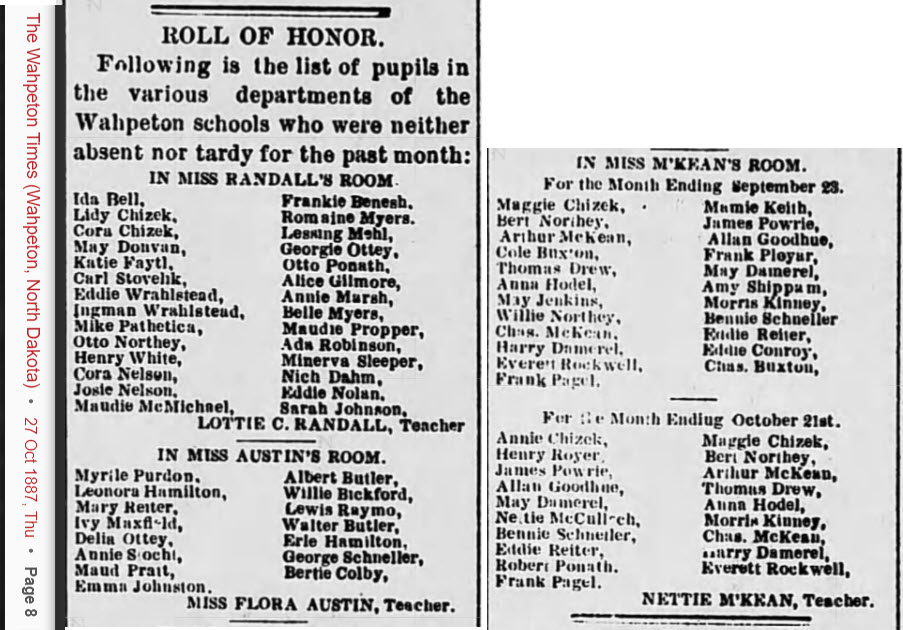Richland County Stories
STORIES FROM THE PAST1887 - School Honor Roll
Media: The Wahpeton Times
Publish Date: 27 OCT 1887

1919-Jasmer Hit by Lighting
Media: Hankinson News
Publish Date: June 5, 1919
Fred Jasmer, son of Mr. and Mrs. Charles Jasmer, Brightwood Township, was knocked senseless by a bolt of lighting during the thunderstorm Saturday afternoon. The accident occurred while Fred was driving a stallion along the road west of town, near the slaughter house. The injured young man was brought to town and given medical attention, but it was a couple of hous before he recovered consciousness. It is not thought he would suffer any permanent ill effects.
1950: Death Notice:Florence Divet
Media: Fargo
Publish Date: ~1950
Written by A.G. (Guy) Divet Published by the Fargo Forum in 1950
In 1882 Florence Divet contracted a fever and died. A few days later baby, Cyrus became ill with the fever and died also. They were buried in the Wild Rice Cemetery. When Fred, age 9 or 10, died of diphtheria he was buried in the little burying ground in the northwest corner of Root's farm, south of Mooreton. When spring came the Divet's planted a boxelder tree at the head of Fred's grave.
It was a little sprig and by some odd chance it threw up three trunks from the root, making a rather symmetrical spreading tree as it grew to maturity. That tree is the only marker that has ever stood guard over that little grave. The following summer, the bodies of Florence and Cyrus were moved from the Wild Rice Cemetery to the place where Fred had been buried. The children of the neighborhood, who died in the epidemic, were buried nearby and in time little markers of marble were erected over their graves; Root, Bacchus, Haftes, Coltz, but only the three trunked tree marked the graves of the Divets..
Bonanza Farming Movement
Media: Book
Publish Date: Unclear
Author: Mrs. Elaine Wold
(Organized 1879-Began operation 1880)
During the 1870s-1890s a phenomenon took place in the Red River Valley, which was part of
the larger, westward movement, known today as Bonanza Farming.
The principal reason for the development of these large holdings was the inexpensive but highly productive lands that could be acquired from the railroads for only a small outlay of cash. Many of these farms were bought at an outlay of little more than a dollar an acre, since the railroad believed it profitable to dispose of lands along their right-of-ways at a low rate in order to be assured of more freight moving both ways. Many Eastern investors took advantage of these purchases. Usually the bonanza farms were railroad lands in alternate or checkerboard sections.
Hiram N. Drache, in his book 'The Day of the Bonanza' writes: Best known of all the bonanzas in Richland County was the Dwight Farm, owned by the Dwight Farm & Land Company, headed by Congressman John W. Dwight of Dryden, New York. It had twelve stockholders, two of them being Charles Cady and John Miller, both of whom were superintendents, and became later political leaders in North Dakota. John Miller, who became North Dakota's first governor, became the farm president in 1896. Purchases from the railroad amounted to 17,000 acres scattered throughout 9 townships, until a total of 27,000 acres were secured. An additional 32,000 acres were secured in the Finley area of Steele County, making a total of 60,000 acres.
The farm was divided into 3 units, but only the Dwight Headquarters Farm had buildings of any size. After 1900 the land was gradually sold, until in 1909 there was only 6,000 acres in Richland County and 4,800 in Steele County remaining. John Miller was virtual owner at the time of his death. The stock was worth $336 per share, and the total net worth of the company in 1909 was $413,000 with about 11,000 acres of land remaining. Crandall, in his 1886 book A History of Richland County, adds: The company has built a large barn that will hold 150 head of cattle. In use on this farm are about 200 horses and mules, 44 binders, 8 steam threshers, 50 gang and sulky plows and 45 seeders. The company has graded about 50 miles of road and has four railroad stations upon its own land in Richland County. The cultivated portion with Headquarters at Dwight, has a head bookkeeper, an assistant bookkeeper, a general foreman of division one, a general foreman of division two, a foreman of machinery houses, one foreman for stables, and one gang foreman or about every 15 laborers. 0. J. Wakefield is the wheat inspector and overseer of the 60,000 capacity elevator.
However, the large-scale method of farming, after reaching great heights, soon headed for a downfall. Outside capital often lacked good management to make farming profitable. This, combined with crop failures in the 1880s, was a major factor in the decline of bonanza farming in the early 1900s. Constant farming of land with no consideration given to crop rotation, summer fallow, or fertilization caused the consequent depletion on the soil, which also was in a large part responsible for the downfall. Many of the large holders found it profitable to break up their farms into smaller ones. Others said finding a dependable labor supply caused the break-up also. When Iver Namtvedt, whose son Harold now lives on the headquarters farm, bought the ho1dings in 1941, the acreage included 5,000 acres. All in all, bonanza farming was an important factor in bringing settlers to this area.
Bagg Family Farm
Paper: Unknown
Publish Date: Unknown